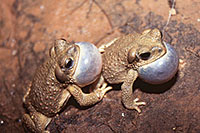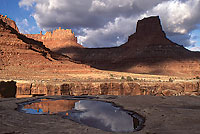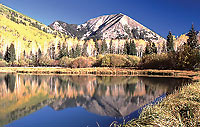You might not think of frogs and salamanders as part of the native fauna in the Southwest, but they are. Canyon streams, wetlands and ephemeral pools all represent excellent habitat for these amphibians. And the spring season represents an excellent time of year to hear, and view, these desert dwellers.
 In spring, male frogs and toads chorus to attract mates, announce their availability to breed and defend territories. Their calls can travel through the air, the water or even through the ground, sometimes initiating a sleuth’s search for the source of the sound.
In spring, male frogs and toads chorus to attract mates, announce their availability to breed and defend territories. Their calls can travel through the air, the water or even through the ground, sometimes initiating a sleuth’s search for the source of the sound.
The males do the talking, producing sound by inflating and compressing a thin membrane of skin located below their mouth. Depending upon the species, there is a single or a double air sac that inflates like a balloon. Air is forced from the lungs into the air sac which makes it resonate and produce sound. And when one frog calls, others join in on the chorus.
 Writer Larry Hyslop described an encounter with canyon treefrogs in Zion National Park in his book, Beeplants and Whiptails. “Across the pond, the now familiar call of a male frog is a sound much too loud for such a small frog. It is nothing humans would call beautiful, although I assume it sounds good to a female frog.” The treefrog’s call is often described as “the bleating of a sheep with a cold,” but obviously it gets the job done.
Writer Larry Hyslop described an encounter with canyon treefrogs in Zion National Park in his book, Beeplants and Whiptails. “Across the pond, the now familiar call of a male frog is a sound much too loud for such a small frog. It is nothing humans would call beautiful, although I assume it sounds good to a female frog.” The treefrog’s call is often described as “the bleating of a sheep with a cold,” but obviously it gets the job done.
The call attracts females to where the males are located and breeding takes place. You might see the male attached atop the female in an embrace called “amplexus.” The male fertilizes the female’s eggs, which are produced by the hundreds in gelatinous sacs.
Some are produced as a massive blob, others as a long string. Just as the male’s calls are unique, so too are the egg masses of the female.
 These amphibians need an aquatic site in which to lay their eggs to keep them from drying out. Careful observations might turn up the eggs, but it is easier to locate the adults still hanging around the areas.
These amphibians need an aquatic site in which to lay their eggs to keep them from drying out. Careful observations might turn up the eggs, but it is easier to locate the adults still hanging around the areas.
Although named “treefrogs,” you might find the canyon treefrogs clinging to a rocky pool rim or sitting atop a partially submerged rock more than perched in a tree. Small suction cups on the tips of the toes enable them to cling to these vertical walls, and their ash-gray coloration helps them to be somewhat cryptic and blend in with their surroundings.
In contrast to treefrog’s bleat, the call of Woodhouse’s toads sounds like a screeching complaint, “waaaaaaa!” These calls pierce the night air from these large hockey puck-shaped toads with a white ventral stripe. The toad’s skin is covered in warts and protected by a viscous toxin that causes inflammation, burning and possible death to any predator that attempts to eat one of these toads.
 Tadpoles of both the treefrog and toad may be vulnerable to predation by fish, aquatic invertebrates, salamander larvae and conditions of the water in which they live. Not immune to the desiccation of their aquatic homes, these toads race through their larval life stage to become adults. Often only a small percentage of the hatched eggs will mature to adulthood, so for these amphibians, survival is a numbers game.
Tadpoles of both the treefrog and toad may be vulnerable to predation by fish, aquatic invertebrates, salamander larvae and conditions of the water in which they live. Not immune to the desiccation of their aquatic homes, these toads race through their larval life stage to become adults. Often only a small percentage of the hatched eggs will mature to adulthood, so for these amphibians, survival is a numbers game.
Besides these two amphibs, there are others that inhabit the desert. Tiger salamanders, red-spotted toads, Western toads and leopard frogs now face some competition from introduced bullfrogs. The bullfrog’s classic “jug-o-rum” call is hard to miss and a sharp contrast to the high-pitched trill of the red-spotted toad.
So during your next spring outing, keep an ear open for these unexpected desert creatures. You might find their calls to be a bit loud and continuous making it hard to sleep, but it is also a comforting sound knowing these creatures are alive and well in a unique environment.

 In spring, male frogs and toads chorus to attract mates, announce their availability to breed and defend territories. Their calls can travel through the air, the water or even through the ground, sometimes initiating a sleuth’s search for the source of the sound.
In spring, male frogs and toads chorus to attract mates, announce their availability to breed and defend territories. Their calls can travel through the air, the water or even through the ground, sometimes initiating a sleuth’s search for the source of the sound.  Writer Larry Hyslop described an encounter with canyon treefrogs in Zion National Park in his book, Beeplants and Whiptails. “Across the pond, the now familiar call of a male frog is a sound much too loud for such a small frog. It is nothing humans would call beautiful, although I assume it sounds good to a female frog.” The treefrog’s call is often described as “the bleating of a sheep with a cold,” but obviously it gets the job done.
Writer Larry Hyslop described an encounter with canyon treefrogs in Zion National Park in his book, Beeplants and Whiptails. “Across the pond, the now familiar call of a male frog is a sound much too loud for such a small frog. It is nothing humans would call beautiful, although I assume it sounds good to a female frog.” The treefrog’s call is often described as “the bleating of a sheep with a cold,” but obviously it gets the job done.  These amphibians need an aquatic site in which to lay their eggs to keep them from drying out. Careful observations might turn up the eggs, but it is easier to locate the adults still hanging around the areas.
These amphibians need an aquatic site in which to lay their eggs to keep them from drying out. Careful observations might turn up the eggs, but it is easier to locate the adults still hanging around the areas. Tadpoles of both the treefrog and toad may be vulnerable to predation by fish, aquatic invertebrates, salamander larvae and conditions of the water in which they live. Not immune to the desiccation of their aquatic homes, these toads race through their larval life stage to become adults. Often only a small percentage of the hatched eggs will mature to adulthood, so for these amphibians, survival is a numbers game.
Tadpoles of both the treefrog and toad may be vulnerable to predation by fish, aquatic invertebrates, salamander larvae and conditions of the water in which they live. Not immune to the desiccation of their aquatic homes, these toads race through their larval life stage to become adults. Often only a small percentage of the hatched eggs will mature to adulthood, so for these amphibians, survival is a numbers game.